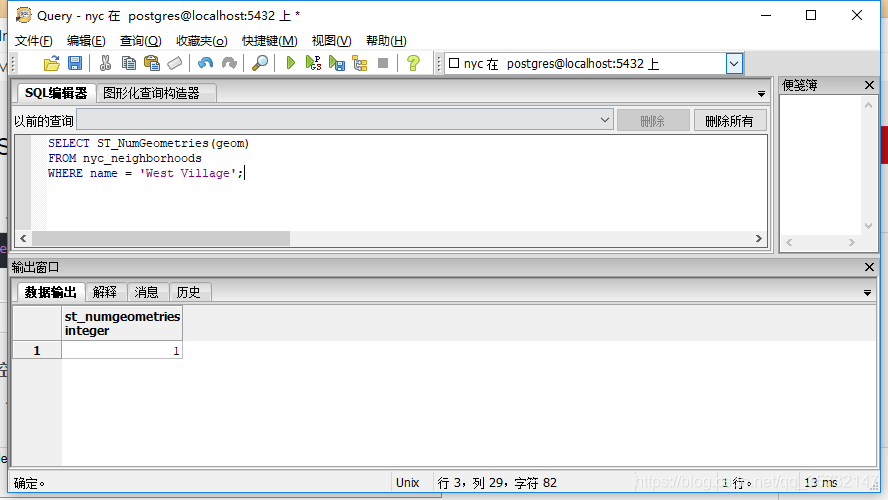PostGIS教程八:关于几何图形的练习
目录
一、函数列表
以下是我们迄今为止看到的所有函数的提示,它们应该对练习有用!
- sum(expression) aggregate to return a sum for a set of records
- count(expression) aggregate to return the size of a set of records
- ST_GeometryType(geometry) returns the type of the geometry
- ST_NDims(geometry) returns the number of dimensions of the geometry
- ST_SRID(geometry) returns the spatial reference identifier number of the geometry
- ST_X(point) returns the X ordinate
- ST_Y(point) returns the Y ordinate
- ST_Length(linestring) returns the length of the linestring
- ST_StartPoint(geometry) returns the first coordinate as a point
- ST_EndPoint(geometry) returns the last coordinate as a point
- ST_NPoints(geometry) returns the number of coordinates in the linestring
- ST_Area(geometry) returns the area of the polygons
- ST_NRings(geometry) returns the number of rings (usually 1, more if there are holes)
- ST_ExteriorRing(polygon) returns the outer ring as a linestring
- ST_InteriorRingN(polygon, integer) returns a specified interior ring as a linestring
- ST_Perimeter(geometry) returns the length of all the rings
- ST_NumGeometries(multi/geomcollection) returns the number of parts in the collection
- ST_GeometryN(geometry, integer) returns the specified part of the collection
- ST_GeomFromText(text) returns
geometry - ST_AsText(geometry) returns WKT
text - ST_AsEWKT(geometry) returns EWKT
text - ST_GeomFromWKB(bytea) returns
geometry - ST_AsBinary(geometry) returns WKB
bytea - ST_AsEWKB(geometry) returns EWKB
bytea - ST_GeomFromGML(text) returns
geometry - ST_AsGML(geometry) returns GML
text - ST_GeomFromKML(text) returns
geometry - ST_AsKML(geometry) returns KML
text - ST_AsGeoJSON(geometry) returns JSON
text - ST_AsSVG(geometry) returns SVG
text
还有请记住我们现在数据库中已经有的表:
nyc_census_blocks- blkid, popn_total, boroname, geom
nyc_streets- name, type, geom
nyc_subway_stations- name, geom
nyc_neighborhoods- name, boroname, geom
二、练习
①’West Village‘社区(neighborhood)的面积是多少?
SELECT ST_Area(geom)
FROM nyc_neighborhoods
WHERE name = 'West Village';
![]()

注意:面积以平方米为单位。要得到一个以公顷为单位的面积,需要再对其除以10000;要得到一个以英亩为单位的面积,需要对其除以4047。
②曼哈顿(Manhattan)的面积是多少英亩?(提示:nyc_census_blocks和nyc_neighborhoods中都有boroname – rorough name – 行政区名)
SELECT Sum(ST_Area(geom)) / 4047
FROM nyc_neighborhoods
WHERE boroname = 'Manhattan';
![]()

或者:
SELECT Sum(ST_Area(geom)) / 4047
FROM nyc_census_blocks
WHERE boroname = 'Manhattan';
![]()

③纽约市(New York City)有多少个人口普查区(census blocks)多边形里有孔洞?
SELECT Count(*)
FROM nyc_census_blocks
WHERE ST_NumInteriorRings(ST_GeometryN(geom,1)) > 0;
注意:ST_NRings()函数可能让人感觉可以胜任,但是它也计算多-多边形的外环和内环。为了运行ST_NumInteriorRings(),我们需要将MultiPolygon几何图形转换为简单的多边形,因此,我们使用ST_GeometryN()从每个集合中提取第一个多边形。
![]()

④“纽约市(New York)的街道总长度(公里)是多少?(提示:空间数据的测量单位是米,每公里有1000米)
SELECT Sum(ST_Length(geom)) / 1000
FROM nyc_streets;
![]()

⑤’Columbus Cir‘(哥伦布环)有多长?
SELECT ST_Length(geom)
FROM nyc_streets
WHERE name = 'Columbus Cir';
![]()

⑥”West Village‘边界的JSON表示是怎样的?”
SELECT ST_AsGeoJSON(geom)
FROM nyc_neighborhoods
WHERE name = 'West Village';


返回的JSON里的几何类型是”MultiPolygon(多重多边形)”,有趣!
⑦”West Village“多重多边形(MultiPolygon)中有多少个多边形?
SELECT ST_NumGeometries(geom)
FROM nyc_neighborhoods
WHERE name = 'West Village';
![]()
注意:在空间表中找到单元素多重多边形并不少见。使用多重多边形允许只有一种几何图形类型的表同时存储单(single-)几何图形和多(multi-)几何图形,而不使用混合类型。

⑧按类型列出纽约市街道长度是多少?
SELECT type, Sum(ST_Length(geom)) AS length
FROM nyc_streets
GROUP BY type
ORDER BY length DESC;

注意:ORDER BY length DESC子句按长度以降序形式排序。
转载自:https://blog.csdn.net/qq_35732147/article/details/85338695



